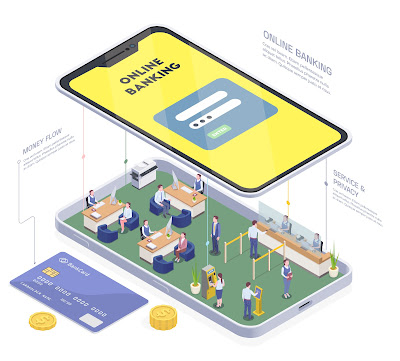Introduction to Mobile Banking Applications Development:
In recent years, the proliferation of smartphones has revolutionized the way people manage their finances. Mobile banking applications have become indispensable tools for users to conveniently access banking services on the go. With the surge in demand for mobile banking solutions, businesses are keen on developing robust, user-friendly applications to cater to their customers' needs. This guide aims to provide insights into the process, features, cost considerations, and security aspects of mobile banking app development.
Process of Mobile Banking App Development:
Research and Planning: The development process begins with thorough market research and an understanding of the target audience's needs. Identifying competitors and analyzing their offerings can help in devising a unique value proposition for the app.
Design: User experience (UX) and user interface (UI) design are crucial aspects of mobile banking app development. Designers focus on creating intuitive interfaces that facilitate seamless navigation and ensure accessibility for users of all demographics.
Development: The development phase involves coding the app according to the specified requirements. Mobile banking apps are typically developed for multiple platforms, including iOS and Android, using languages like Swift (for iOS) and Kotlin or Java (for Android).
Testing: Rigorous testing is conducted to identify and rectify any bugs or glitches in the application. Testing includes functional testing, usability testing, security testing, and compatibility testing across various devices and operating systems.
Deployment: Once the app is thoroughly tested and refined, it is ready for deployment on app stores such as the Apple App Store and Google Play Store. App store optimization techniques may be employed to enhance visibility and attract users.
Features of Mobile Banking Applications:
Account Management: Users can view their account balances, and transaction history, and manage multiple accounts from within the app.
Fund Transfers: The app enables users to transfer funds between their accounts, to other bank accounts, or to third-party payment services securely.
Bill Payments: Users can pay bills, utilities, and invoices directly through the app, eliminating the need for manual payments.
Mobile Deposits: Some banking apps allow users to deposit checks by simply capturing photos of the checks using their smartphone cameras.
Card Management: Users can manage their debit and credit cards, including blocking or activating cards, setting spending limits, and receiving transaction alerts.
ATM/Branch Locator: Integration with location-based services enables users to locate nearby ATMs and branches for convenient access to banking services.
Personal Finance Management: Advanced features such as budgeting tools, expense tracking, and financial insights help users manage their finances effectively.
Cost Considerations for Mobile Banking App Development:
The cost of developing a mobile banking app can vary significantly depending on factors such as:
Features and Complexity: The more features and functionalities the app offers, the higher the development costs. Complex features like biometric authentication, AI-powered chatbots, and data analytics capabilities may require additional investment.
Platform: Developing separate apps for iOS and Android platforms increases development costs compared to building a cross-platform app using frameworks like React Native or Flutter.
Design: High-quality UI/UX design contributes to a positive user experience but may entail higher design costs.
Security: Implementing robust security measures, such as end-to-end encryption, multi-factor authentication, and compliance with regulatory standards, adds to the development costs.
Maintenance and Updates: Ongoing maintenance, updates, and technical support are essential for ensuring the app's performance and security over time, contributing to long-term costs.
Engaging an iOS App Development Company:
When selecting an IOS app development company for mobile banking app development, consider the following factors:
Experience and Expertise: Choose a company with extensive experience in developing secure, scalable iOS applications, preferably with a portfolio that includes mobile banking or fintech projects.
Reputation and Reviews: Research the company's reputation, client testimonials, and reviews to gauge their reliability, professionalism, and customer satisfaction.
Security Practices: Ensure that the company follows industry best practices for security and compliance with regulations such as GDPR, PSD2, and PCI DSS.
Communication and Collaboration: Effective communication and collaboration are vital for project success. Choose a company that maintains transparent communication channels and involves clients in the development process.
Cost and Budget: While cost is an important consideration, prioritize quality and value for money over cheap solutions. Request detailed cost estimates and consider the company's pricing structure and payment terms.
Security Considerations in Mobile Banking App Development:
Security is paramount in mobile banking app development to protect users' sensitive financial information and prevent unauthorized access or fraudulent activities. Key security measures include:
Encryption: Implement end-to-end encryption to secure data transmission between the app and the banking servers, preventing interception or tampering by malicious actors.
Authentication: Utilize robust authentication mechanisms such as biometric authentication (fingerprint, facial recognition) and multi-factor authentication (passwords, PINs, OTPs) to verify users' identities and prevent unauthorized access.
Secure APIs: Ensure that APIs used for integrating with banking systems and third-party services adhere to industry standards for security and encryption.
Compliance: Adhere to regulatory standards and compliance requirements, such as GDPR, PSD2, and PCI DSS, to safeguard user data and ensure data privacy and security.
Regular Audits and Penetration Testing: Conduct regular security audits and penetration testing to identify and mitigate vulnerabilities in the app and infrastructure.
Conclusion:
Mobile banking application development plays a vital role in enabling users to conveniently manage their finances anytime, anywhere. Successful development of a mobile banking app requires careful planning, robust features, adherence to security best practices, and collaboration with experienced iOS app development companies. By prioritizing user experience, security, and regulatory compliance, businesses can build trust with their customers and drive the adoption of their mobile banking solutions in a competitive market landscape.
Read More About This Post: Mobile Banking App Development Guide: Process, Features, Cost, And Security

No comments:
Post a Comment